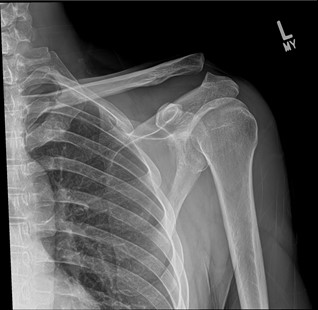Causes
Acromioclavicular (AC) joint connects the scapula to the clavicle. The acromioclavicular ligament and coracoclavicular ligaments work together to stabilize the joint. An AC joint sprain most commonly occurs from a hard fall or direct trauma. This results in the separation of the ligaments at the end of the clavicle. Treatment is based on the severity of the injury.
Symptoms of an AC joint sprain:
(1) Tenderness at the end of the clavicle
(2) Obvious deformity
(3) Pain with motion
(4) Difficulty with strength
(5) An “unstable” shoulder
(6) Swelling or bruising

Diagnosis
Severity and stability of the joint is determined with a physical exam. There is usually an obvious deformity of the shoulder when sprained. A worse deformity can be indicative of a high grade of sprain. An x-ray is taken in the office to rule out fracture or dislocation. A CT scan may be recommended if the injury is severe.

Non-Surgical Treatment
Non-surgical treatment goal is to reduce pain, restore range of motion and create stability. Grade I or II separations are usually recommended conservative treatment.
Rest: Resting the injured joint is the first step to reduce swelling and pain. Keeping it immobilized for the first 1-2 weeks will help with pain. Be sure to use the arm gently within a week to avoid a frozen shoulder.
Ice: In the first 24 hours of an injury, ice it to reduce swelling and pain.
Heat: After 24 hours have passed, a heating pad or hot compress can help.
NSAIDS (non-steroidal anti-inflammatory drugs): Reduce pain and swelling through NSAIDS such as ibuprofen (Advil), naproxen (Aleve), or aspirin.
Physical therapy and exercise: Gentle exercises and stretches designed to strengthen the muscles surrounding the shoulder joint.
Patients can expect full recovery with conservative treatment between 2-4 months.

Surgical Treatment
When the sprain is severely unstable (III, IV or V), Dr. Nicholson will recommend an Augmented Weaver Dunn or AC joint reconstruction procedure to stabilize the joint. This is an open procedure where Dr. Nicholson will perform a distal clavicle resection and ligament reconstruction. He will first remove the end of the clavicle to allow the joint to move freely. Then, he will attach the coracoacromial ligament to the end of the clavicle. The joint will be better aligned and more stable.
Typical recovery time for this procedure involves 4 weeks in a sling and physical therapy for 8-12 weeks. Patients return to light duty between 2-3 months and full duty between 4-6 months. Patients can expect a stabilized joint but it is common to continue to have a small step-off between the clavicle and shoulder blade.

